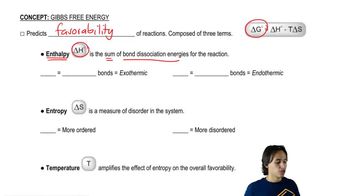Here are the essential concepts you must grasp in order to answer the question correctly.
Gibbs Free Energy
Gibbs Free Energy (G) is a thermodynamic potential that helps predict whether a process will occur spontaneously at constant temperature and pressure. It is calculated using the equation ΔG = ΔH - TΔS, where ΔH is the change in enthalpy, T is the temperature in Kelvin, and ΔS is the change in entropy. A negative ΔG indicates a spontaneous process, while a positive ΔG suggests non-spontaneity.
Recommended video:
Breaking down the different terms of the Gibbs Free Energy equation.
Enthalpy (ΔH)
Enthalpy (ΔH) is a measure of the total heat content of a system. A positive ΔH indicates that the process is endothermic, meaning it absorbs heat from the surroundings. This can affect the spontaneity of a reaction, as higher energy input may be required to drive the process, especially if the entropy change is not favorable.
Recommended video:
Entropy (ΔS)
Entropy (ΔS) is a measure of the disorder or randomness in a system. A positive ΔS indicates an increase in disorder, which generally favors spontaneity. In the context of the Gibbs Free Energy equation, a larger positive ΔS can offset a positive ΔH, potentially leading to a negative ΔG and making the process more favorable at higher temperatures.
Recommended video:
Explaining what entropy is.






